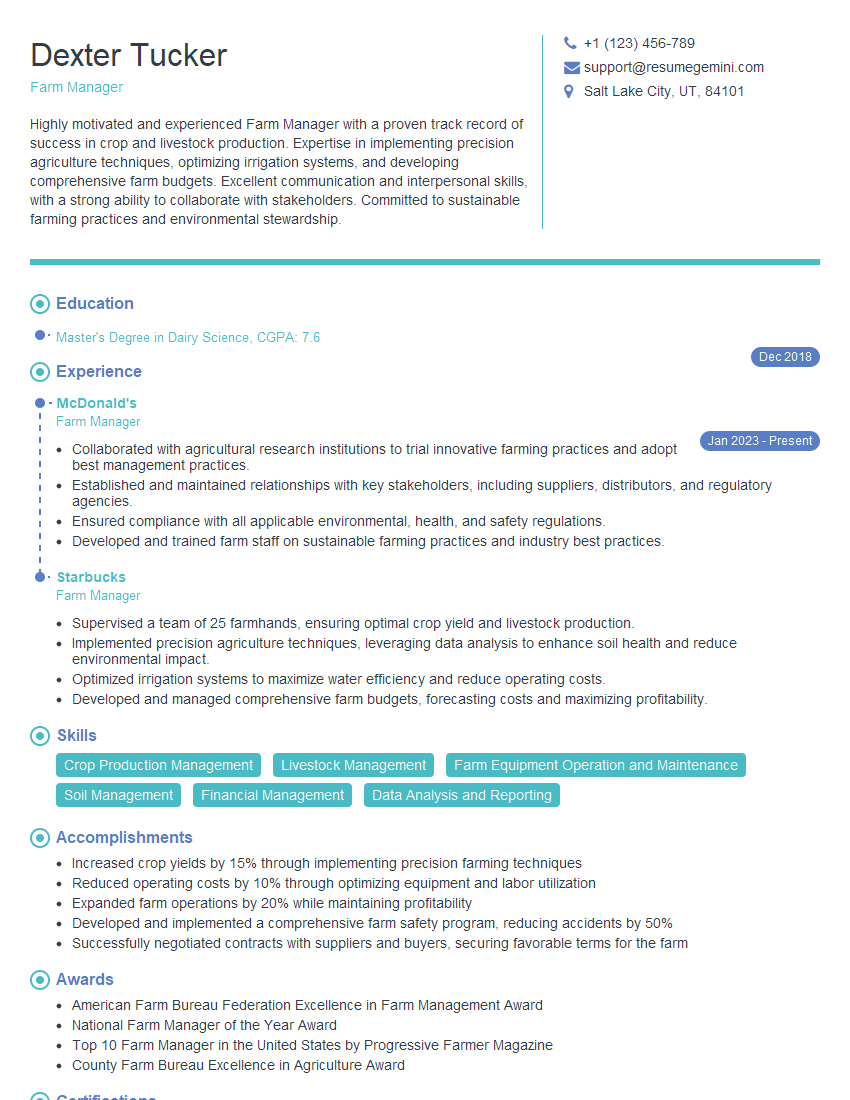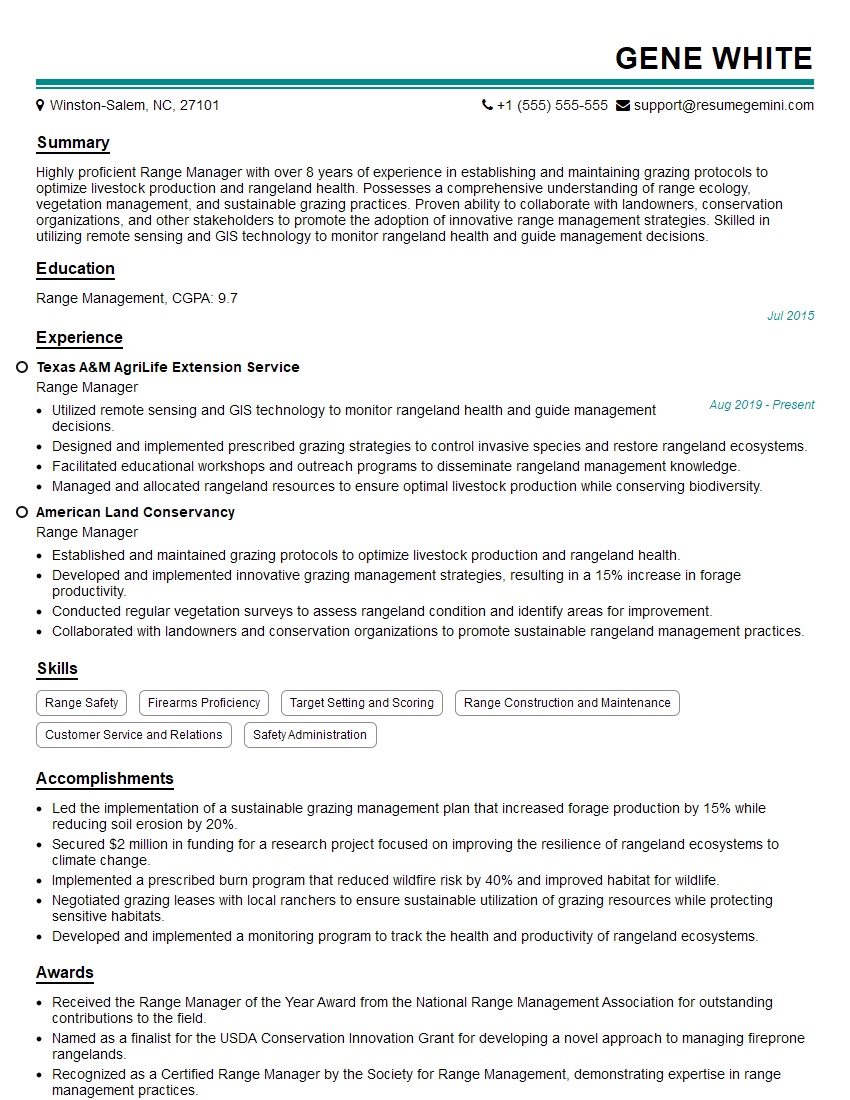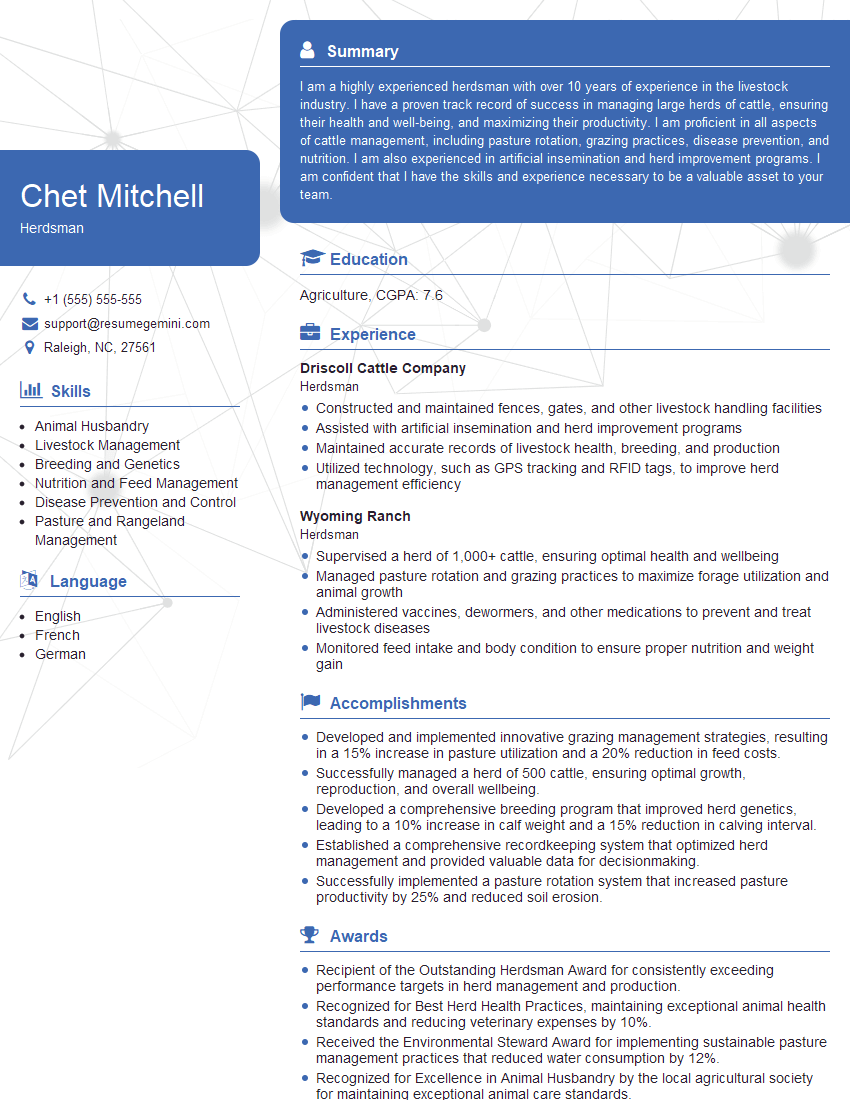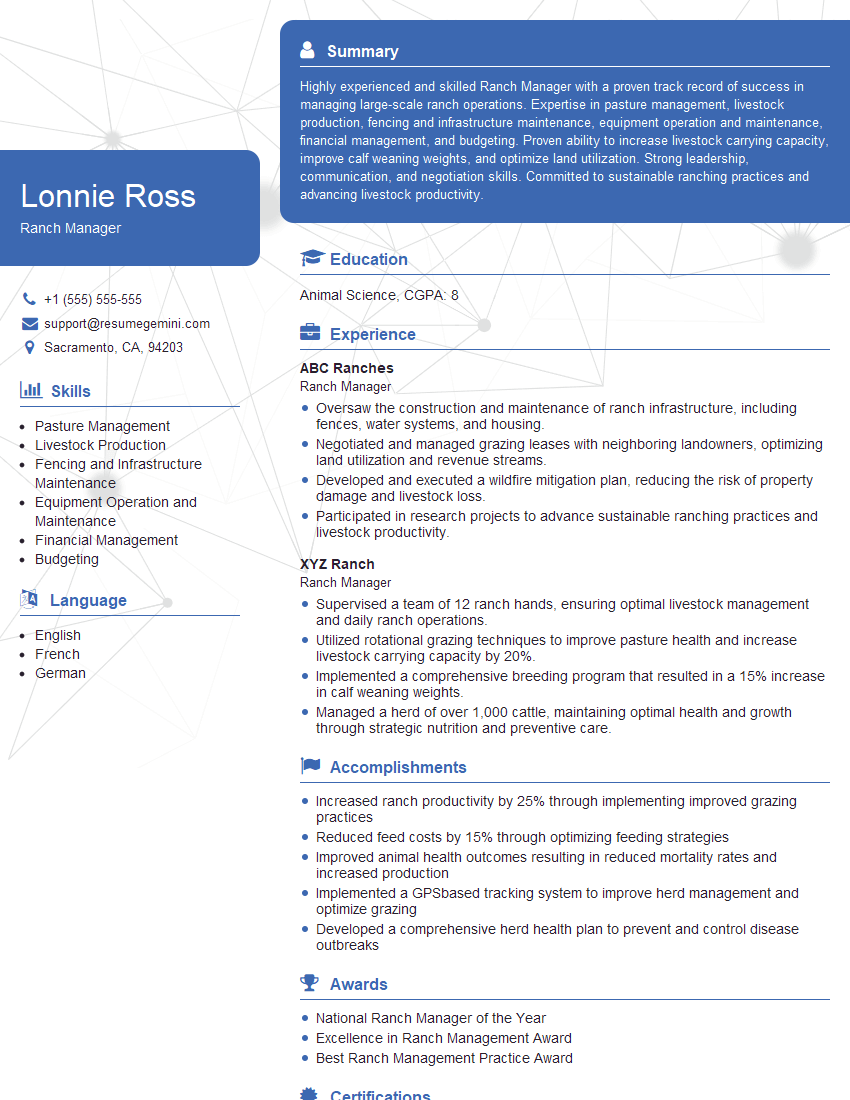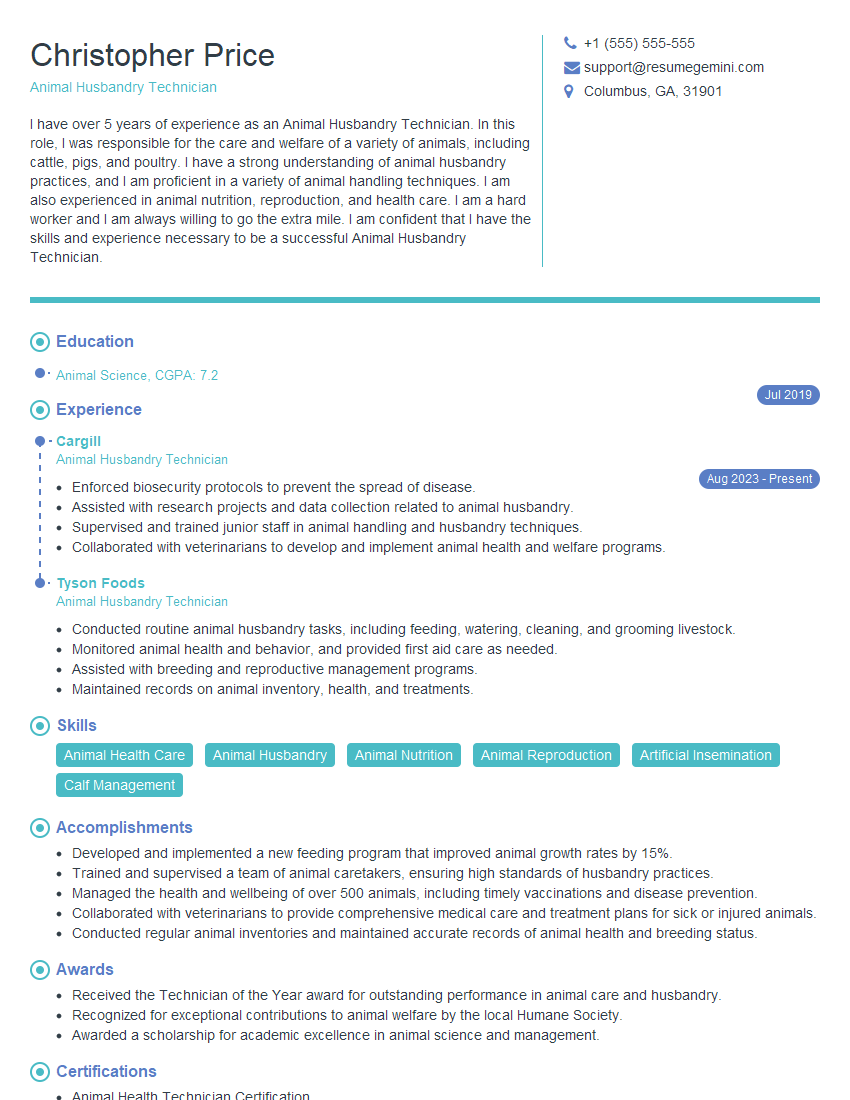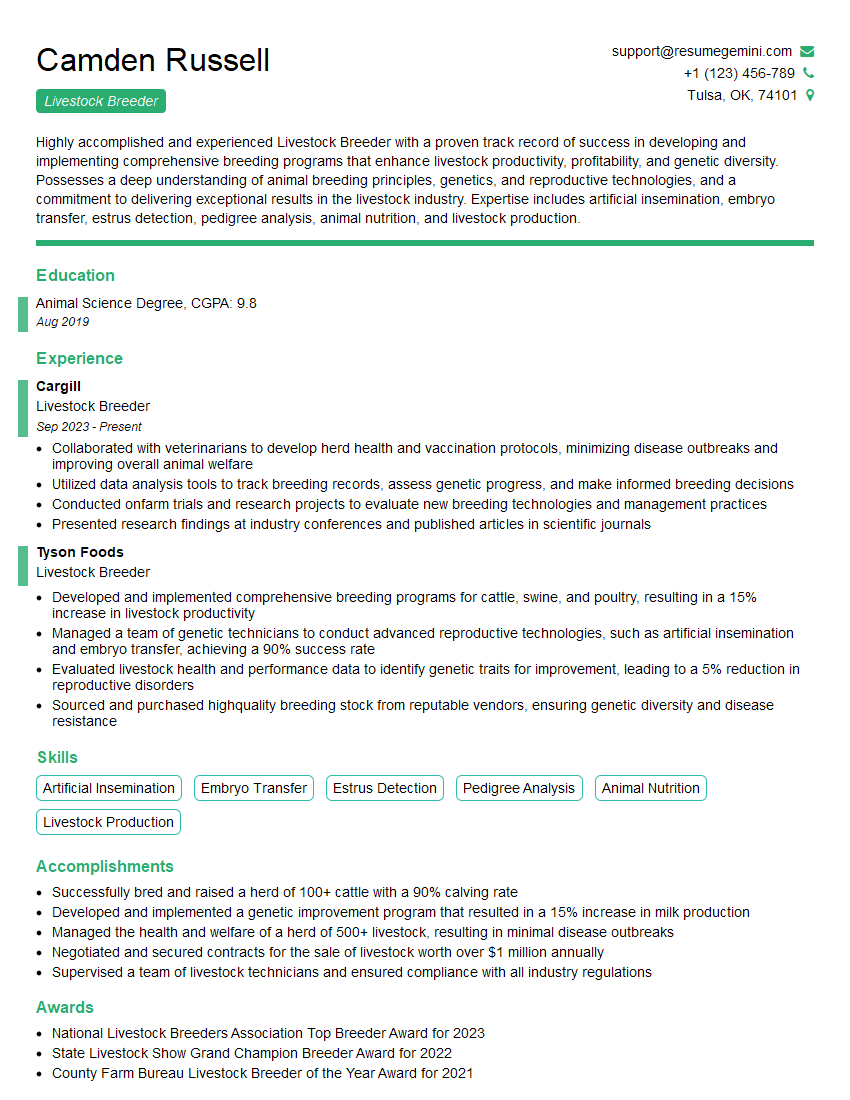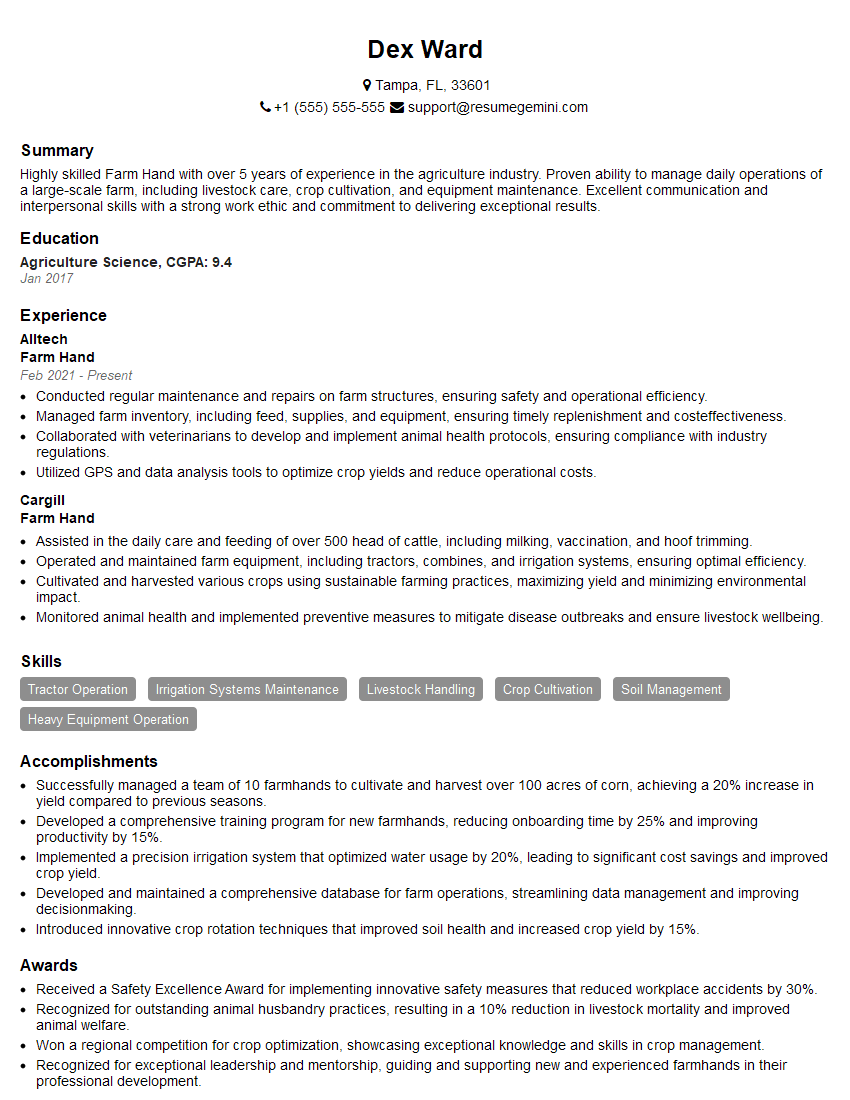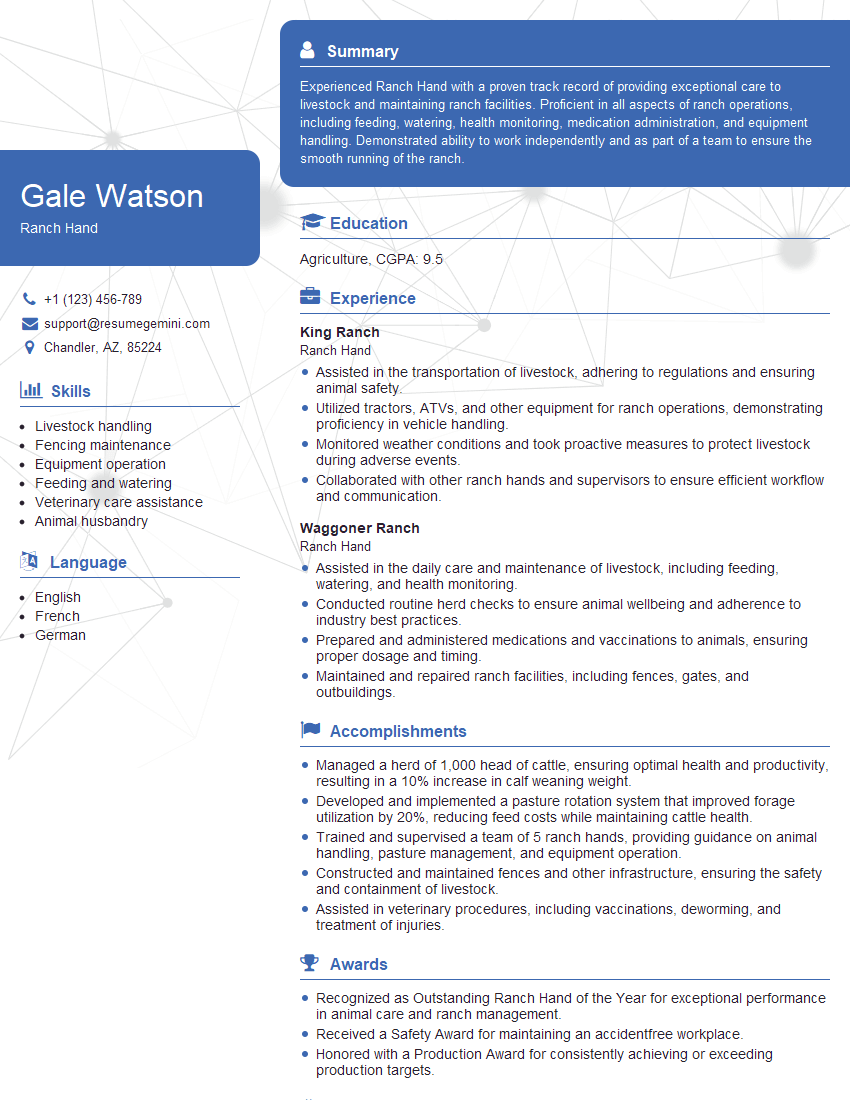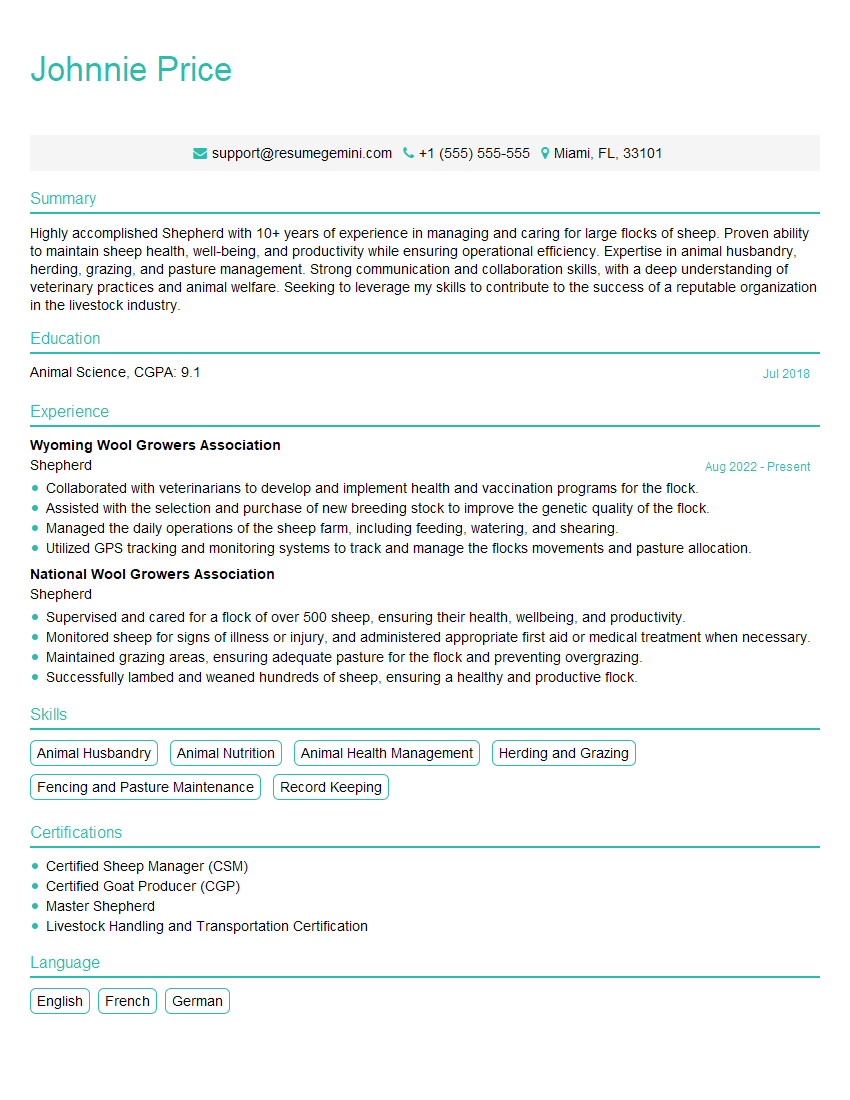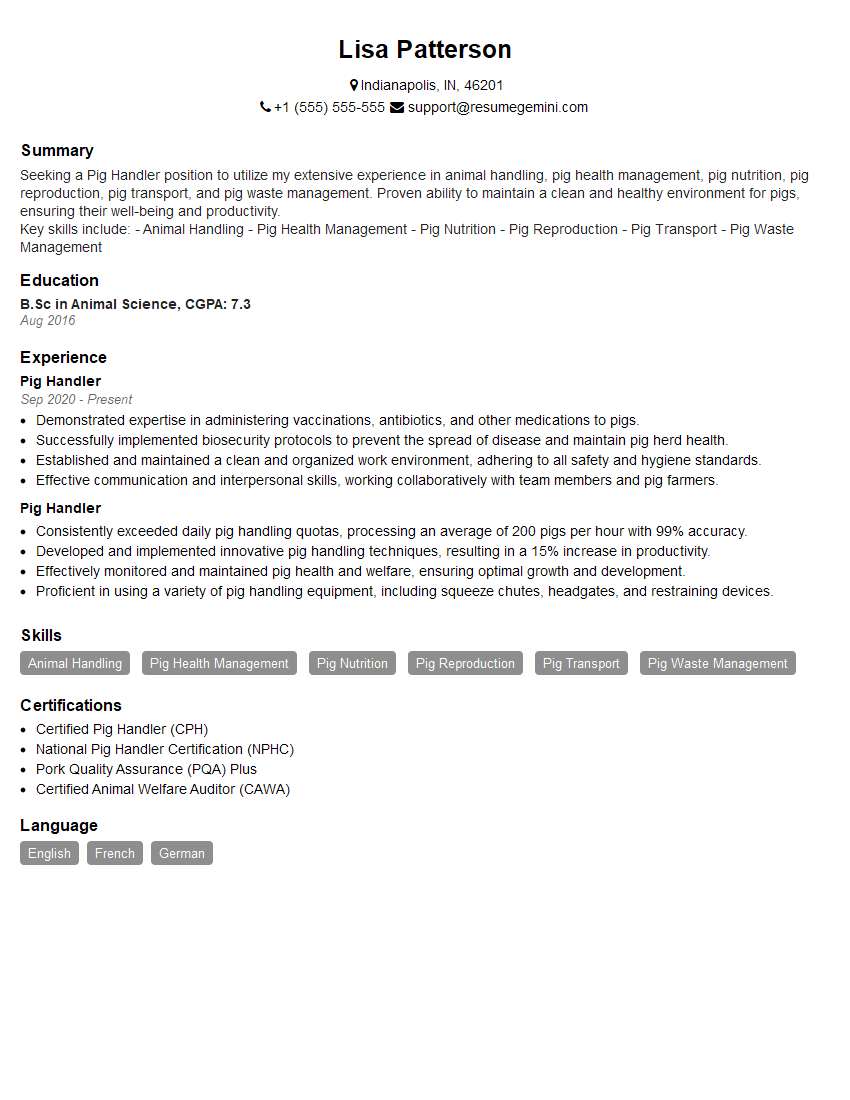Cracking a skill-specific interview, like one for Stockmanship, requires understanding the nuances of the role. In this blog, we present the questions you’re most likely to encounter, along with insights into how to answer them effectively. Let’s ensure you’re ready to make a strong impression.
Questions Asked in Stockmanship Interview
Q 1. Describe your experience handling different livestock species.
My experience spans over 15 years working with diverse livestock, including cattle (both beef and dairy breeds), sheep, goats, pigs, and poultry. I’ve worked on large-scale commercial operations, smaller family farms, and even assisted with research projects involving animal behavior and handling. This broad experience has provided me with a deep understanding of the unique needs and characteristics of each species. For instance, handling dairy cattle requires a gentler approach than working with beef cattle due to their temperament and sensitivity to stress. Similarly, sheep are easily startled and require careful herding techniques, unlike the more robust nature of pigs.
- Cattle: Experienced in various handling procedures, from routine vaccinations and health checks to more complex procedures such as artificial insemination and pregnancy diagnosis.
- Sheep & Goats: Proficient in flock management, including shearing, worming, and lambing/kidding assistance. Experienced in handling both docile and more assertive breeds.
- Pigs: Skilled in managing piglets, breeding sows, and finishing pigs. Understand the specific challenges of maintaining hygiene and preventing injuries in pig handling.
- Poultry: Experienced in managing laying hens and broilers, including catching, vaccination, and egg collection. Familiar with various housing systems and biosecurity protocols.
Q 2. Explain your understanding of animal behavior and its impact on handling.
Understanding animal behavior is fundamental to effective and safe livestock handling. Animals react to their environment and stimuli, and recognizing these responses is key to minimizing stress. For example, flight zone awareness is crucial. The flight zone is the animal’s personal space; if you enter it, the animal will move away. Understanding this allows handlers to predict and control movement. Other crucial behavioral aspects include understanding herd dynamics (dominant/submissive animals), body language (tail swishing, ear position, vocalizations), and species-specific communication styles.
Ignoring animal behavior leads to increased stress, injuries (both to animals and handlers), and reduced productivity. A stressed animal is more likely to resist handling, resulting in dangerous situations. For example, a frightened cow may kick or charge, causing injury. Conversely, calm and confident handling leads to more cooperative animals, easier procedures, and improved animal welfare.
Q 3. What are the key principles of low-stress livestock handling?
Low-stress livestock handling centers around minimizing fear and discomfort. The core principles include:
- Understanding Animal Behavior: As discussed previously, recognizing flight zones, body language, and herd dynamics is fundamental.
- Minimizing Noise and Sudden Movements: Loud noises and abrupt movements can startle animals and trigger a fight-or-flight response.
- Using Gentle, Calm Handling Techniques: Patience and a calm demeanor are crucial. Avoid quick movements or forceful restraint.
- Creating a Comfortable and Predictable Environment: Provide adequate space, shade, and water. Consistent handling routines help animals feel secure.
- Using Appropriate Handling Equipment: Using correctly sized and properly maintained equipment, such as curved panels, reduces stress and injuries.
- Positive Reinforcement: Rewarding calm behavior through positive reinforcement can improve future handling experiences.
For example, instead of chasing a cow into a chute, a well-trained handler might use subtle movements and the cow’s natural tendency to follow other cattle to guide it calmly into the desired area.
Q 4. How do you identify and address signs of stress or illness in livestock?
Identifying stress and illness in livestock requires keen observation. Signs of stress can include increased respiration rate (panting), restlessness, abnormal vocalizations, loss of appetite, and changes in behavior (e.g., isolation from the herd). Signs of illness might include lameness, lethargy, discharge from eyes or nose, changes in fecal consistency, and decreased milk production (in dairy animals).
Addressing these issues requires prompt action. If stress is observed, investigate the cause (e.g., overcrowding, poor handling, environmental factors). If illness is suspected, consult a veterinarian for diagnosis and treatment. Accurate record keeping is crucial to track animal health and identify potential problems early.
Q 5. What are your methods for safely restraining animals for various procedures?
Safe restraint is crucial for various procedures like vaccinations, treatments, and examinations. The method should match the species and procedure. For cattle, head halters and squeeze chutes are commonly used. For sheep and goats, a simple head restraint or a tilting table can be effective. Pigs often require more specialized handling equipment, such as pig boards or slings. Poultry is typically restrained by hand, using gentle but firm grip.
In all cases, the goal is to minimize discomfort and prevent injuries. Overly forceful restraint is counterproductive and can cause injury to both the animal and the handler. Always prioritize safety for both.
Q 6. Describe your experience with livestock transportation and welfare.
My experience in livestock transportation emphasizes animal welfare. This includes ensuring proper loading and unloading procedures, adequate ventilation and space within the transport vehicle, and minimizing journey time. Overcrowding, inadequate ventilation, and long journeys are major contributors to stress and injury during transport. I’m familiar with all relevant regulations and best practices to ensure the safe and humane transportation of animals. This involves careful planning to minimize stress during loading, transport, and unloading. Using proper equipment and techniques significantly improves animal welfare and reduces the risk of injury or death.
Q 7. How do you maintain accurate livestock records and inventories?
Accurate record keeping is essential for effective livestock management. I use a combination of paper and electronic records. This includes individual animal identification (ear tags, microchips), health records (vaccinations, treatments, illnesses), production records (milk yield, weight gain, offspring), and inventory tracking. Digital record-keeping systems allow for easier data analysis and reporting, which can improve management decisions. Regular audits of records ensure accuracy and help identify any inconsistencies or missing data. This information is critical for regulatory compliance and efficient farm management.
Q 8. Explain your approach to preventative livestock health management.
Preventative livestock health management is the cornerstone of successful and profitable animal husbandry. It’s about proactive strategies to minimize disease and maximize animal well-being, rather than simply reacting to problems. My approach is based on three key pillars: biosecurity, nutrition, and proactive veterinary care.
Biosecurity: This involves minimizing the introduction of pathogens onto the farm. Think of it like creating a fortress against disease. This includes strict hygiene protocols – disinfecting equipment, controlling access to the farm, and isolating new animals for quarantine. For example, I always insist on foot dips at the entrance to each paddock to prevent the spread of diseases like footrot. Implementing strict biosecurity measures significantly reduced the incidence of IBR (Infectious Bovine Rhinotracheitis) on one farm I managed, saving considerable veterinary costs.
Nutrition: Well-nourished animals are more resilient to disease. This means providing a balanced diet appropriate to the animal’s age, breed, and physiological state. Regular pasture monitoring to ensure sufficient forage quantity and quality is crucial, as is providing supplementary feed when needed. A deficiency in selenium, for instance, can lead to white muscle disease. By analyzing soil samples and tailoring our feeding strategies accordingly, we can successfully avoid such deficiencies.
Proactive Veterinary Care: This isn’t just about reacting to illness. It’s about scheduling regular health checks, vaccinations, and parasite control programs. Early detection and intervention are crucial. For instance, regular weighing of calves helps us identify growth problems early, allowing for prompt adjustments to their diet or veterinary intervention. I work closely with vets to develop customized health plans for each herd, tailoring them to specific risks and local conditions. A proactive approach, such as regular foot trimming, can prevent lameness issues down the line.
Q 9. How do you handle aggressive or injured animals?
Handling aggressive or injured animals requires a calm, confident approach prioritizing both animal and human safety. The first step is always assessment. How severe is the injury? What’s causing the aggression? Is the animal in pain? Then, depending on the situation, different strategies are implemented.
Aggressive Animals: I avoid direct confrontation. Instead, I use techniques like creating an escape route, using calm body language, and understanding the animal’s behavior to identify the trigger for aggression. Sometimes a simple change of environment can reduce stress and improve behavior. If necessary, I will use appropriate restraint techniques with the assistance of trained personnel, never jeopardizing my own safety.
Injured Animals: The focus shifts to minimizing pain and providing immediate care. This might involve isolating the animal, providing pain relief (under veterinary guidance), and cleaning and dressing any wounds. Severe injuries require immediate veterinary attention and possibly transportation to a suitable facility.
Safety is paramount. In any situation involving aggressive or injured animals, I will always prioritize my own safety and the safety of others. Using appropriate protective equipment, like sturdy boots and gloves, is crucial.
Q 10. What are your strategies for preventing livestock escapes or injuries?
Preventing livestock escapes and injuries involves a multi-faceted approach focusing on infrastructure, animal handling, and training. It’s about creating a safe and secure environment for both the animals and the people who work with them.
Fencing: Regular inspections are vital. I regularly check for damaged wires, posts, or gaps. We use various fence types depending on the livestock and terrain, including electric fences (excellent for containing cattle and sheep), woven wire fences for durability, and post and rail for certain situations. Using the right type of fence for the right terrain and livestock is essential.
Gating Procedures: Clear procedures for opening and closing gates are crucial to prevent escapes. It’s important to train all personnel thoroughly in safe gate handling practices. Always check gates are properly latched after passing through them.
Animal Handling: Careful and well-trained animal handling practices minimize stress and the risk of injury for both animals and handlers. Gentle, non-threatening techniques are employed at all times. Avoid sudden movements or loud noises that can spook the animals. This includes careful planning for loading and unloading animals for transportation, reducing potential injury and panic.
Regular Pasture Maintenance: Removing obstacles or hazards within the pasture also helps. We regularly inspect and clear areas of debris and sharp objects that could cause injury. Maintaining fences reduces escape risk and subsequent injuries.
Q 11. Describe your experience with different types of fencing and pasture management.
My experience with different fencing types and pasture management is extensive. The choice of fencing depends on several factors: the type of livestock, terrain, budget, and the level of security required.
Electric Fencing: Highly effective and cost-efficient for containing cattle, sheep, and goats. Regular maintenance, including checking the power supply and fence integrity, is essential for its effectiveness. I’ve found that electric netting is particularly useful for temporary grazing or rotational grazing systems.
Woven Wire Fencing: Durable and robust, providing excellent security. It’s ideal for areas with high escape risks. The cost is higher than electric fencing, but the longevity makes it worthwhile in certain situations.
Post and Rail Fencing: Often used for aesthetics or in areas where visual barriers are needed, but it offers less containment than other options, especially with strong animals. It’s a less common choice for livestock unless combined with other systems.
Pasture Management: Rotational grazing is a key component of my approach. It enhances pasture quality, reduces parasite burdens, and improves animal health. This involves dividing paddocks into smaller units and rotating livestock between them, allowing each paddock to recover before grazing again. I also incorporate strategies for weed control, soil testing to optimize fertilization, and water management to improve pasture productivity.
Q 12. How do you ensure the welfare of livestock during extreme weather conditions?
Ensuring livestock welfare during extreme weather is vital. My strategies vary depending on the type of weather event:
Heat Stress: This involves providing shade, access to plenty of fresh water, and potentially modifying feeding schedules to reduce metabolic heat production. I’ve had success using misting systems or fans to cool animals during heatwaves. Recognizing the early signs of heat stress—such as panting and reduced feed intake—is key to prompt intervention.
Cold Stress: Providing adequate shelter, windbreaks, and access to dry bedding are crucial. I have experience using thermal imaging cameras to monitor animal body temperatures in cold conditions to early detect animals vulnerable to hypothermia. We also sometimes provide supplementary feed to increase energy reserves and help animals maintain body temperature.
Severe Storms: Animals require secure shelter during storms. This includes ensuring the integrity of buildings and fences, and having contingency plans for moving animals to safer locations if necessary. Checking for injuries after severe storms is essential.
Regular monitoring of animal behavior is critical in any extreme weather conditions. Early identification of distress signs allows for prompt intervention and prevents significant losses.
Q 13. Explain your knowledge of livestock nutrition and feeding practices.
Livestock nutrition is fundamental to productivity and animal health. It’s not just about feeding; it’s about providing a balanced diet that meets the animal’s specific needs. My approach starts with understanding the animal’s requirements based on factors such as breed, age, productivity (e.g., milk yield, weight gain), and physiological state (e.g., pregnancy, lactation).
Forage Evaluation: This is a cornerstone of my approach. Regular pasture assessments, including forage species identification, biomass estimations, and nutritional analysis, allow us to determine whether the pasture is providing sufficient nutrients or if supplementation is needed.
Supplementary Feeding: This is often crucial, especially during periods of nutritional deficiency or high demand (e.g., lactation). We use high-quality feedstuffs, such as concentrates, minerals, and vitamins, to meet the animal’s nutrient requirements.
Water Availability: Access to clean, fresh water is non-negotiable. I consistently check water sources for cleanliness and adequacy.
Feed Management: This includes storage, handling, and distribution of feed to minimize losses and prevent contamination. Proper feed storage prevents spoilage and reduces waste, saving money in the long run.
I regularly work with nutritionists to formulate diets tailored to the specific needs of each herd. For example, providing a mineral supplement tailored to a region with selenium deficiency in the soil can lead to improved reproduction rates and overall animal health.
Q 14. How do you monitor and control parasite infestations in livestock?
Monitoring and controlling parasite infestations is a continuous process that requires an integrated strategy. It’s crucial to prevent significant economic losses and health problems in livestock.
Monitoring: This involves regular fecal egg counts (FEC) to assess parasite burdens. I’ve found that implementing regular FEC testing allows for early detection of increasing worm burdens, and the ability to intervene early when parasitic infections are less severe and before they have an economic effect.
Strategic Dosing: I don’t advocate for blanket drenching (treating the entire herd regardless of infection levels). Targeted treatment, based on FEC results, is far more effective and reduces the development of drug resistance. I have worked on farms where strategic drenching programmes were successfully implemented resulting in a decreased number of treatments required and a significant reduction in drenching costs.
Pasture Management: Rotational grazing plays a crucial role in parasite control. By rotating animals between paddocks, the parasite lifecycle is interrupted, reducing the accumulation of infective larvae.
Alternative Control Measures: I explore other methods such as breeding resistant animals, biological control agents (beneficial nematodes), and pasture management techniques to minimize parasite loads. A multi-pronged approach is always the best strategy.
Record-keeping is paramount. Detailed records of FEC results, treatments, and pasture management practices are vital for evaluating the effectiveness of the parasite control program and making any necessary adjustments.
Q 15. What are your methods for managing livestock breeding programs?
Managing livestock breeding programs requires a holistic approach, focusing on genetic improvement, reproductive efficiency, and animal welfare. It starts with selecting superior breeding stock based on performance records (e.g., milk yield, growth rate, meat quality), pedigree analysis, and visual appraisal. I utilize proven breeding techniques like artificial insemination (AI) and embryo transfer to improve genetic merit efficiently and accelerate progress. For example, using AI allows us to introduce superior genetics from a bull without needing to physically house him. Embryo transfer allows for rapid multiplication of the genes from exceptional cows. Accurate record-keeping is crucial; I use software to monitor breeding cycles, track pregnancies, and record birth data. This data is analyzed to identify trends, assess reproductive efficiency, and inform breeding decisions. Regular health checks and optimal nutrition are also pivotal for reproductive success. Ultimately, a well-managed breeding program aims for increased profitability through improved offspring quality and efficiency.
Career Expert Tips:
- Ace those interviews! Prepare effectively by reviewing the Top 50 Most Common Interview Questions on ResumeGemini.
- Navigate your job search with confidence! Explore a wide range of Career Tips on ResumeGemini. Learn about common challenges and recommendations to overcome them.
- Craft the perfect resume! Master the Art of Resume Writing with ResumeGemini’s guide. Showcase your unique qualifications and achievements effectively.
- Don’t miss out on holiday savings! Build your dream resume with ResumeGemini’s ATS optimized templates.
Q 16. Describe your experience with livestock vaccinations and disease control.
My experience with livestock vaccinations and disease control is extensive. I work with veterinarians to develop and implement comprehensive vaccination protocols tailored to the specific needs of the herd or flock, taking into account the age, breed, and local disease prevalence. This includes routine vaccinations against common diseases like bovine respiratory disease (BRD) in cattle, and various viral and bacterial infections in other species. Beyond vaccination, I emphasize biosecurity measures to prevent disease introduction (as discussed below). Early disease detection is critical; I regularly monitor animals for signs of illness, utilizing quick tests if needed, and isolate sick animals promptly to prevent outbreaks. I have experience managing disease outbreaks, including implementing quarantine protocols, administering treatments as prescribed by the veterinarian, and working with regulatory agencies to control the spread of disease. Good record-keeping regarding vaccinations and treatments is vital for tracking disease incidence, assessing vaccine efficacy, and meeting regulatory requirements. One key success story was implementing a new vaccination program that significantly reduced the incidence of BRD in a herd, resulting in a notable increase in weight gain and profitability.
Q 17. How do you ensure biosecurity on a farm or ranch?
Biosecurity is paramount for protecting livestock from disease. My approach is multifaceted, starting with strict hygiene protocols. This includes providing handwashing stations, disinfecting footwear, and requiring clean clothing changes for personnel entering and exiting animal areas. I also implement controlled traffic flow to minimize the risk of disease transmission between different groups of animals. We meticulously manage animal waste; proper disposal prevents the buildup of pathogens. Vehicle and equipment disinfection are crucial before they are brought onto the farm. A strict quarantine protocol is followed for any newly introduced animals; they are kept separate from the existing herd for a designated period to observe for any signs of disease. Regularly testing for diseases, including surveillance testing on healthy animals, helps to detect potential issues before they escalate. In essence, it’s about creating a barrier to protect the herd from external threats. A key element is regular staff training on biosecurity procedures, ensuring everyone understands and adheres to the protocols. This holistic approach minimizes the risk of disease outbreaks and protects the health and productivity of the livestock.
Q 18. What are your strategies for effective communication with farm workers?
Effective communication with farm workers is crucial for a productive and safe working environment. I believe in open and respectful dialogue. I ensure that all instructions are clear, concise, and understood by everyone, often demonstrating techniques visually. Regular meetings are held to discuss updates, address concerns, and provide training. I encourage two-way communication; farm workers feel comfortable expressing their ideas, concerns, or problems without fear of reprisal. I utilize various communication methods: face-to-face discussions, written instructions, and occasionally group briefings. Using visual aids, like diagrams or videos, can significantly improve understanding. Recognizing and appreciating good work fosters motivation and strengthens the team spirit. For example, we recently adopted a system of daily briefings, leading to improved efficiency and a reduction in misunderstandings.
Q 19. Describe your experience with livestock weighing and grading.
Livestock weighing and grading are essential for determining animal value, monitoring growth rates, and making informed management decisions. I use accurate scales, ideally electronic ones for precision, to weigh animals at regular intervals. This data is recorded and analyzed to track individual animal growth and the overall herd’s performance. Grading is equally important. I am proficient in evaluating animals according to established standards, considering factors like conformation, muscling, fat cover, and carcass quality. This often involves visual assessment and may incorporate the use of specialized tools like ultrasound technology for carcass evaluation. This data influences breeding selections, feeding strategies, and marketing decisions. For instance, consistent weighing helps to adjust feed rations to optimize growth, and accurate grading enables us to target specific markets to maximize profit.
Q 20. How do you handle conflicts between animals in a herd or flock?
Handling conflicts within a herd or flock requires understanding the underlying causes. Common reasons include competition for resources (food, water, space), dominance hierarchies, or introduction of new animals. My approach involves identifying the aggressors and victims. Sometimes simple adjustments, such as providing additional feeding stations or water troughs, can alleviate resource-based conflicts. In more severe cases, I may separate the aggressive animals temporarily, allowing them to calm down. Introducing new animals gradually, using a process of slow introduction and close observation, can reduce conflicts during integration. Severe cases might require veterinary intervention, particularly if there are injuries. Regular observation and prompt action prevent minor conflicts from escalating into serious issues that compromise animal welfare and productivity.
Q 21. Explain your understanding of livestock reproductive cycles.
Understanding livestock reproductive cycles is fundamental for efficient breeding management. This includes knowledge of estrous cycles (the period of sexual receptivity), gestation periods (pregnancy length), and parturition (birth). The length and characteristics of these cycles vary among species and breeds. For example, cattle typically have an estrous cycle of about 21 days, while sheep have a shorter cycle. Accurate detection of estrus is crucial for successful breeding. I utilize various methods, including visual observation of behavioral changes (mounting behavior, restlessness), use of heat detection patches, and sometimes hormonal testing. Monitoring pregnancy through palpation or ultrasound scanning ensures early detection of pregnancy and identification of any potential problems. Knowledge of these cycles allows for optimization of breeding strategies, including artificial insemination timing, which results in higher conception rates and improved reproductive efficiency. Understanding factors like nutrition, stress, and environmental conditions influencing reproductive performance is vital to ensure optimal results.
Q 22. What are your experience with livestock marketing and sales?
My experience in livestock marketing and sales spans over 15 years, encompassing various species including cattle, sheep, and pigs. I’ve worked with both small-scale farmers and large agricultural corporations, developing and implementing marketing strategies tailored to their specific needs and market conditions. This includes everything from breed selection and animal preparation for sale to negotiating prices and managing logistics. For example, I successfully negotiated a premium price for a client’s herd of Angus cattle by highlighting their superior genetics and showcasing their performance data to potential buyers. Another key aspect of my work has been identifying optimal sales channels, whether through auction markets, direct sales to processors, or online platforms. I understand the importance of market analysis, understanding seasonal price fluctuations, and adapting sales strategies accordingly to maximize profitability for my clients.
Q 23. How do you comply with relevant animal welfare regulations and legislation?
Compliance with animal welfare regulations is paramount in my work. I’m thoroughly familiar with the Animal Welfare Act and all relevant state and local regulations. This includes understanding and adhering to standards for housing, feeding, transportation, and handling of livestock. My approach involves proactively implementing best practices, including regular health checks, providing adequate space and enrichment, and minimizing stress during handling procedures. For instance, I developed and implemented a comprehensive training program for farm workers on humane handling techniques, significantly reducing animal injuries and improving overall welfare. I also maintain meticulous records of all animal health treatments and procedures to ensure complete transparency and traceability. Regular audits and inspections are welcomed as a means of continuous improvement and verification of our compliance.
Q 24. Describe your experience with implementing sustainable livestock management practices.
Sustainable livestock management is central to my philosophy. My experience includes implementing rotational grazing systems to improve pasture health and reduce soil erosion. This involves carefully managing grazing periods and allowing adequate rest periods for pasture regeneration. I’ve also worked with farms to adopt integrated pest management strategies, reducing reliance on chemical pesticides and minimizing environmental impact. For example, I helped one farm implement a cover cropping program to improve soil fertility and reduce the need for synthetic fertilizers. Furthermore, I’ve advised on the use of efficient water management techniques to conserve resources and minimize waste. Ultimately, my goal is to balance economic viability with environmental stewardship, ensuring the long-term health of the land and the animals.
Q 25. How do you use technology to improve livestock management efficiency?
Technology plays a crucial role in modern livestock management. I’m proficient in using various software and hardware solutions to enhance efficiency. This includes using precision livestock farming technologies such as electronic identification (EID) tags for individual animal tracking, monitoring feed intake and weight gain, and detecting early signs of disease. I also utilize herd management software to streamline record-keeping, automate tasks, and generate comprehensive reports on animal performance and profitability. For example, I implemented a system using sensors and data analytics to monitor environmental conditions in barns, optimizing ventilation and temperature control to improve animal health and productivity. This led to a significant reduction in animal stress and improved overall herd health.
Q 26. What are your strategies for troubleshooting common livestock health issues?
Troubleshooting livestock health issues requires a systematic approach. I start with careful observation of the animals, noting any changes in behavior, appetite, or physical condition. This is followed by a thorough review of their management practices, including diet, housing, and handling. I then utilize diagnostic tools such as blood tests and fecal examinations to pinpoint the underlying cause of the problem. I’m experienced in administering various treatments, from simple medications to more complex interventions. In cases requiring specialized expertise, I collaborate with veterinarians to ensure the best possible care. For instance, I successfully identified and resolved an outbreak of respiratory disease in a herd of cattle by implementing timely vaccination programs and improving barn ventilation.
Q 27. How do you prioritize tasks and manage time effectively in a fast-paced livestock environment?
Effective time management in a fast-paced livestock environment relies on prioritization and planning. I use a combination of techniques, including daily task lists, scheduling software, and proactive problem-solving to optimize my workflow. High-priority tasks, such as attending to sick animals or ensuring timely feeding, are addressed immediately. I delegate tasks where appropriate and employ efficient work processes to minimize time spent on routine activities. For instance, I developed a standardized checklist for daily farm operations, reducing the likelihood of overlooking critical tasks and ensuring consistency in animal care. Regular review and adjustments to my schedule allow for flexibility and responsiveness to unexpected events.
Q 28. Describe a time you had to make a difficult decision regarding animal welfare.
One of the most difficult decisions I faced involved a cow with a severe leg injury. The injury was so extensive that veterinary treatment was deemed unlikely to be successful, and the cow was suffering significant pain. While euthanasia was the most humane option, it was an emotionally challenging decision, as I value each animal under my care. Before making the final decision, I consulted with the farm owner and the veterinarian, ensuring that we considered all possible alternatives and followed established animal welfare protocols. The decision, although difficult, was ultimately made in the best interest of the animal’s welfare, prioritizing its relief from suffering.
Key Topics to Learn for Stockmanship Interview
- Animal Husbandry: Understanding animal health, nutrition, and welfare practices. Practical application: Describing your experience with preventative health measures, dietary adjustments based on animal needs, and recognizing signs of illness or stress.
- Livestock Handling Techniques: Safe and efficient methods for moving, restraining, and handling various livestock species. Practical application: Detailing your proficiency in low-stress handling techniques and explaining how you’ve adapted your approach for different animal temperaments and situations.
- Breeding and Genetics: Principles of selective breeding, genetic improvement, and record-keeping. Practical application: Explaining your understanding of herd improvement strategies and how you’ve used data to make informed breeding decisions.
- Pasture Management: Sustainable grazing practices, rotational grazing, and forage utilization. Practical application: Describing your experience in optimizing pasture utilization and minimizing environmental impact.
- Facility Management: Design, maintenance, and biosecurity of livestock facilities. Practical application: Explaining your knowledge of facility design principles related to animal welfare and efficiency, including hygiene and disease prevention.
- Problem-Solving and Decision-Making in Stockmanship: Analyzing situations, identifying potential problems, and developing effective solutions in a livestock setting. Practical application: Providing examples where you’ve solved a livestock-related challenge, highlighting your analytical and problem-solving skills.
- Record Keeping and Data Analysis: Maintaining accurate records and using data to inform management decisions. Practical application: Describing your experience using technology and data to track animal performance, health, and productivity.
Next Steps
Mastering stockmanship is crucial for career advancement in the agricultural sector, opening doors to leadership roles and specialized opportunities. A well-crafted resume is your first step toward securing your dream job. Make sure your resume is ATS-friendly to maximize your chances of getting noticed. ResumeGemini is a trusted resource for building professional, impactful resumes that catch the eye of recruiters. We provide examples of resumes tailored specifically to Stockmanship roles to help you present your skills and experience effectively.
Explore more articles
Users Rating of Our Blogs
Share Your Experience
We value your feedback! Please rate our content and share your thoughts (optional).
What Readers Say About Our Blog
Hello,
We found issues with your domain’s email setup that may be sending your messages to spam or blocking them completely. InboxShield Mini shows you how to fix it in minutes — no tech skills required.
Scan your domain now for details: https://inboxshield-mini.com/
— Adam @ InboxShield Mini
Reply STOP to unsubscribe
Hi, are you owner of interviewgemini.com? What if I told you I could help you find extra time in your schedule, reconnect with leads you didn’t even realize you missed, and bring in more “I want to work with you” conversations, without increasing your ad spend or hiring a full-time employee?
All with a flexible, budget-friendly service that could easily pay for itself. Sounds good?
Would it be nice to jump on a quick 10-minute call so I can show you exactly how we make this work?
Best,
Hapei
Marketing Director
Hey, I know you’re the owner of interviewgemini.com. I’ll be quick.
Fundraising for your business is tough and time-consuming. We make it easier by guaranteeing two private investor meetings each month, for six months. No demos, no pitch events – just direct introductions to active investors matched to your startup.
If youR17;re raising, this could help you build real momentum. Want me to send more info?
Hi, I represent an SEO company that specialises in getting you AI citations and higher rankings on Google. I’d like to offer you a 100% free SEO audit for your website. Would you be interested?
Hi, I represent an SEO company that specialises in getting you AI citations and higher rankings on Google. I’d like to offer you a 100% free SEO audit for your website. Would you be interested?
good
